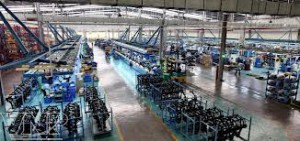 Vietnam plans to develop supporting industries to attract foreign investments. A cooperation agreement was signed recently between N&G Investment and Development JSC and General Production, which represents 150 Japanese foundries and metal casting manufacturers. Under the agreement, a foundry complex covering an area of 127 hectares would be set up in the Hanoi Southern Supporting Industrial Park & Urban Services (Hanssip). Parts and accessories to be manufactured at the complex would be provided to automobile and agricultural machine manufacturers.
Vietnam plans to develop supporting industries to attract foreign investments. A cooperation agreement was signed recently between N&G Investment and Development JSC and General Production, which represents 150 Japanese foundries and metal casting manufacturers. Under the agreement, a foundry complex covering an area of 127 hectares would be set up in the Hanoi Southern Supporting Industrial Park & Urban Services (Hanssip). Parts and accessories to be manufactured at the complex would be provided to automobile and agricultural machine manufacturers.
The project has been applauded by Vietnamese agencies and local officials because it will help develop supporting industries, an objective that Vietnam aspires to. Binh Duong provincial authorities are moving ahead with plans to develop supporting industries in their locality. The centerpiece of their plans is a 300 hectare industrial zone specifically designed for satellite businesses which will make materials and auxiliary accessories to provide to big manufacturers.
The zone, expected to be located in the 1,000 hectare Bau Bang Industrial Park in the province, would mostly accommodate paper and footwear production. The provincial authorities are also joining forces with the local wooden furniture and fine arts association to work out a plan to create a concentrated production zone for furniture manufacturers. If the plan succeeds, there will be a close supply chain in Binh Duong Province which can satisfy all the manufacturers’ demands.
The major weakness of Vietnam, in the eyes of foreign investors, is the lack of supporting industries. Because of this, they often find it difficult to find reliable accessories and materials suppliers in Vietnam. This explains why the government of Vietnam and local authorities have laid a red carpet to welcome investors in supporting industries.
However, the supporting industries development strategy was kicked off many years ago, and relatively little progress has been made so far. In the textile & garment sector, for example, Vietnam still finds itself importing $9 billion worth of material from China to serve domestic production. The failures of a series of projects in supporting industries have given analysts reason to remain doubtful about the feasibility of the new projects.



